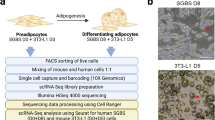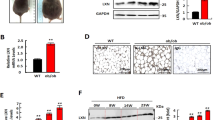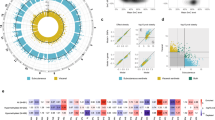Abstract
Coordination of cell differentiation and proliferation is a key issue in the development process of multi-cellular organisms and stem cells. Here we provide evidence that the establishment of adipocyte differentiation of 3T3-L1 cells requires two processes: the licensing of an adipogenesis gene-expression program within a particular growth-arrest stage, i.e., the contact-inhibition stage, and then the execution of this program in a cell-cycle-independent manner, by which the licensed progenitors are differentiated into adipocytes in the presence of inducing factors. Our results showed that differentiation licensing of 3T3-L1 cells during the contact-inhibition stage involved epigenetic modifications such as DNA methylation and histone modifications, whereas disturbing these epigenetic modifications by DNA methylation inhibitors or RNAi during the contact-inhibition stage significantly reduced adipogenesis efficiency. More importantly, when these licensed 3T3-L1 cells were re-cultured under non-differentiating conditions or treated only with insulin, this adipogenesis commitment could be maintained from one cell generation to the next, whereby the licensed program could be activated in a cell-cycle-independent manner once these cells were subjected to adipogenesis-inducing conditions. This result suggests that differentiation licensing and differentiation execution can be uncoupled and disparately linked to cell proliferation. Our findings deliver a new concept that cell-fate decision can be subdivided into at least two stages, licensing and execution, which might have different regulatory relationships with cell proliferation. In addition, this new concept may provide a clue for developing new strategies against obesity.
Similar content being viewed by others
Log in or create a free account to read this content
Gain free access to this article, as well as selected content from this journal and more on nature.com
or
References
Scott RE, Florine DL, Wille Jr JJ, Yun K . Coupling of growth arrest and differentiation at a distinct state in the G1 phase of the cell cycle: GD. Proc Natl Acad Sci USA 1982; 79:845–849.
Skapek SX, Rhee J, Spicer DB, Lassar AB . Inhibition of myogenic differentiation in proliferating myoblasts by cyclin-D1-dependent kinase. Science 1995; 267:1022–1024.
Maione R, Amati P . Interdependence between muscle differentiation and cell-cycle control. Biochim Biophys Acta 1997; 1332: M19–M30.
Zhu L, Skoultchi AI . Coordinating cell proliferation and differentiation. Curr Opin Genet Dev 2001; 11:91–97.
Scott RE, Hoerl BJ, Wille Jr JJ, Florine DJ, Krawisz BR, Yun K . Coupling of proadipocyte growth arrest and differentiation. II. A cell cycle model for the physiological control of cell proliferation. J Cell Biol 1982; 94:400–405.
Matushansky I, Radparvar F, Skoultchi AI . Reprogramming leukemic cells to terminal differentiation by inhibiting specific cyclin-dependent kinases in G1. Proc Natl Acad Sci USA 2001; 97:14317–14322.
Matushansky I, Radparvar F, Skoultchi AI . CDK6 blocks differentiation: coupling cell proliferation to the block to differentiation in leukemic cells. Oncogene 2003; 22:4143–4149.
Valentinis B, Romano G, Feruzzi F, et al. Growth and differentiation signals by the insulin-like growth factor 1 receptor in hemopoietic cells are mediated through different pathways. J Biol Chem 1999; 274:12423–12430.
Brown G, Drayson MT, Durham J, et al. HL60 cells halted in G1 or S phase differentiate normally. Exp Cell Res 2002; 281:28–38.
Andäng M, Hjerling-Leffler J, Moliner A, et al. Histone H2AX-dependent GABAA receptor regulation of stem cell proliferation. Nature 2008; 451:460–464.
Brown G, Hughes PJ, Michell RH . Cell differentiation and proliferation – simultaneous but independent? Exp Cell Res 2003; 291:282–288.
Pardee AB . G1 events and regulation of cell proliferation. Science 1989; 246:603–608.
Fujito T, Ikeda W, Kakunaga S, et al. Inhibition of cell movement and proliferation by cell-cell contact-induced interaction of Necl-5 with nectin-3. J Cell Biol 2005; 171:165–173.
Coller HA, Sang L, Roberts JM . A new description of cellular quiescence. PLoS Biol 2006; 4:0329–0349.
Otto TC, Lane MD . Adipose development: from stem cell to adipocyte. Crit Rev Biochem Mol Biol 2005; 40:229–242.
MacDougald OA, Lane MD . Transcriptional regulation of gene expression during adipocyte differentiation. Annu Rev Biochem 1995; 64:345–373.
Gregoire FM, Smas CM, Sul HS . Understanding adipocyte differentiation. Physiol Rev 1998; 78:783–809.
Batt DB, Roberts TM . Cell density modulates protein-tyrosine phosphorylation. J Biol Chem 1998; 273:3408–3414.
Arney KL, Fisher AG . Epigenetic aspects of differentiation. J Cell Sci 2004; 117:4355–4363.
Kondo T . Epigenetic alchemy for cell fate conversion. Curr Opin Genet Dev 2006; 16:502–507.
McNairn AJ, Gilbert DM . Epigenomic replication: linking epigenetics to DNA replication. Bioessays 2003; 25:647–656.
Qiu Z, Wei Y, Chen N, Jiang M, Wu J, Liao K . DNA synthesis and mitotic clonal expansion is not a required step for 3T3-L1 preadipocyte differentiation into adipocytes. J Biol Chem 2001; 276:11988–11995.
Patel YM, Lane MD . Mitotic clonal expansion during preadipocyte differentiation: calpain-mediated turnover of p27. J Biol Chem 2000; 275:17653–17660.
Tang QQ, Otto TC, Lane MD . Mitotic clonal expansion: a synchronous process required for adipogenesis. Proc Natl Acad Sci USA 2003; 100:44–49.
Huo H, Guo X, Hong S, Jiang M, Liu X, Liao K . Lipid rafts/caveolae are essential for insulin-like growth factor-1 receptor signaling during 3T3-L1 preadipocyte differentiation induction. J Biol Chem 2003; 278:11561–11569.
Lin FT, Lane MD . CAAT/enhancer binding protein alpha is sufficient to initiate the 3T3-L1 adipocyte differentiation program. Proc Natl Acad Sci USA 1994; 91:8757–8761.
Tada Y, Brena RM, Hackanson B, Morrison C, Otterson GA, Plass C . Epigenetic modulation of tumor suppressor CCAAT/enhancer binding protein alpha activity in lung cancer. J Natl Cancer Inst 2006; 98:396–406.
Ng RK, Gurdon JB . Epigenetic memory of an active gene state depends on histone H3.3 incorporation into chromatin in the absence of transcription. Nat Cell Biol 2008; 10:102–109.
Beaujean N, Taylor J, Gardner J, Wilmut I, Meehan R, Yong L . Effect of limited DNA methylation reprogramming in the normal sheep embryo on somatic cell nuclear transfer. Biol Reprod 2004; 71:185–193.
Acknowledgements
We thank DS Li (Chinese Academy of Scienses, China) for critically reading this article. This work was supported by the “973 Program” No. 2006CB503900, grants from the National Natural Science Foundation of China No. 30230110 and No. 30521005, and a grant from the Knowledge Innovation Program of the Chinese Academy of Sciences KSCX1-YW-02 to JRW.
Author information
Authors and Affiliations
Corresponding author
Supplementary information
Supplementary information, Figure S1
Adipogenesis induction at different cell densities. (PDF 128 kb)
Supplementary information, Figure S2
Effects of DNA methylation inhibitors and siRNA against Dnmt 3a. (PDF 84 kb)
Supplementary information, Figure S3
Mitotic clonal expansion induced by insulin only is similar to that induced by MDI. (PDF 110 kb)
Supplementary information, Figure S4
Verification of microarray results with real-time quantitative PCR. (PDF 49 kb)
Supplementary information, Table S1
Summary of primer sequences, polymerase chain reaction (PCR) condition for bisulfite sequencing. (PDF 19 kb)
Rights and permissions
About this article
Cite this article
Guo, W., Zhang, KM., Tu, K. et al. Adipogenesis licensing and execution are disparately linked to cell proliferation. Cell Res 19, 216–223 (2009). https://doi.org/10.1038/cr.2008.319
Received:
Revised:
Accepted:
Published:
Issue date:
DOI: https://doi.org/10.1038/cr.2008.319
Keywords
This article is cited by
-
Adipocyte nuclei captured from VAT and SAT
BMC Obesity (2016)
-
Epigenetic programming of Dnmt3a mediated by AP2α is required for granting preadipocyte the ability to differentiate
Cell Death & Disease (2016)
-
Cellular differentiation: A two-stage procedure
Nature China (2009)



